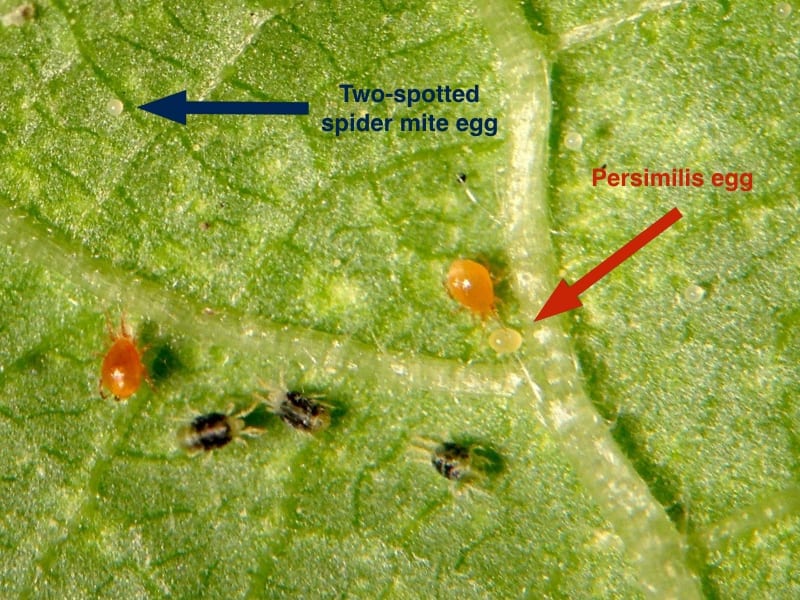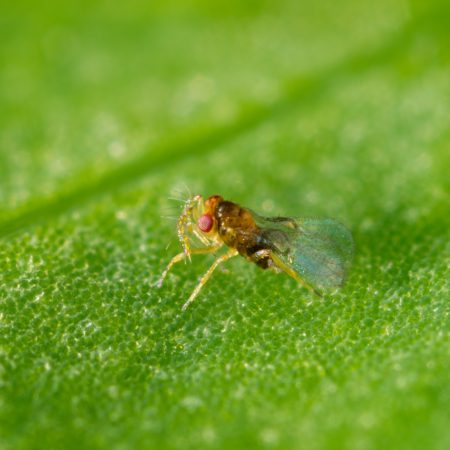Description
Persimilis (Phytoseiulus persimilis) are predatory mites that feed on two- spotted spider mite (TSM) and other spider mite species. Persimilis provide excellent control of these pests in a wide range of crops and they are among the most widely used biocontrol agents globally.
Adult Persimilis feed on all stages of spider mites, eating up to 20 young or 7 adult spider mites per day. Immature Persimilis feed on the eggs and immature stages of spider mites. Persimilis are fast-moving pear-shaped mites. The adults are red or orange and the immature stages are clear. Their eggs are oval shaped, twice the size of TSM eggs, and they develop an orange tinge as they mature. At 25°C Persimilis multiply twice as fast as their prey.
Download our Persimilis technical information sheet here.
Target pests
- Two-spotted spider mite
- Bean spider mite
Advantages
- Applicable in many field and protected crops
- Consume more spider mites per day than other predatory mites
- Eat all spider mite stages
- Fast development
- Spread well in the crop
- Suitable for drone release
Suitable crop environments
Persimilis do well under humid conditions and in crops with heavy foliage. They perform best at 15-28°C and relative humidity above 60%. They have been used successfully in many protected and field crops, including strawberries, cut flowers, hops, raspberries, capsicums, cucumbers, eggplant, ornamentals, blackcurrants, pome fruit and grapes. Persimilis are not suitable for tree crops in dry climates.
Release rates
Unlike chemicals, when it comes to beneficials, more is always better. However, they are costly to produce and our goal is to achieve the best results at minimal expense. There are many factors to consider, including the value of the crop, the severity of the pest outbreak and the activity (or otherwise) of naturally occurring beneficial species.
As a general rule, 2-3 releases of modest numbers is better than a single large release. This reduces risk, improves establishment and accelerates the development of multiple overlapping generations. In most cases our releases are inoculative and we anticipate that our beneficials will establish and breed up within the crop to give long term control.
Release rates will vary depending on the crop and level of infestation. The table below is only a guide – contact us for specific recommendations.
| Situation | Release rate (per release) | No. of releases | Interval between releases |
| Field crops | 3-10 mites/m2 | 1-2 | 1-2 weeks |
| Protected crops | 10-20 mites/m2 | 2-3 | 1-2 weeks |
| Strawberries | Min. 2 mites/plant | 1-2 | 2-3 weeks |
| Hotspot treatments | 20-50 mites/m2 | as required | 1 week |
When to release
Ideally Persimilis should be introduced at the first sign of spider mites. If a hotspot is detected early and treated quickly, Persimilis will follow the pest mites as they spread. Inspect crops regularly for the presence of pest mites, especially on the windward side, in dry spots and at edges. If spider mite numbers are already high, consider applying a compatible miticide prior to release.
How to release
Before release, check prior history of chemical applications to ensure toxic residues are no longer present. See notes on chemical use below.
Persimilis are mixed with vermiculite and packed in cardboard tubes. They should be released as soon as possible after delivery. During very warm weather it is preferable to avoid making releases at the hottest time of day. If necessary, the tubes can be stored (on their side) for up to 3 days at 7-10°C.
Roll the tubes gently before release to distribute mites evenly. Remove the end cap, take away the breathable cloth and replace the cap to use as a shaker. Distribute the contents of each tube over the foliage of infested plants. During release keep an eye out for pest hotspots and be prepared to place additional Persimilis in these areas.
After release
Persimilis will be difficult to find for a week or so after introduction. They disperse quickly in search of food. Mark a few places where predatory mites were released, especially those with good numbers of spider mites. These sites can be checked regularly to assess pest numbers and establishment of predatory mites. Look for Persimilis eggs among colonies of spider mites, as this is a good early sign of predator establishment. Initially spider mite numbers may continue to increase, while Persimilis establishes.
If spider mites increase to damaging levels, a compatible miticide can be applied to reduce pest mite numbers. This will allow the predators to catch up. Spot spraying is preferable to blanket spraying.
Cultural practices to aid establishment
Persimilis thrive under warm, humid conditions while hot, dry, windy and dusty conditions favour spider mites. Plants with dense foliage will automatically provide a favourable microclimate for Persimilis. In some situations you can improve Persimilis establishment by minimising dust and using overhead watering during hot, dry periods. If plants are not touching, a light netting thrown over the crop can help Persimilis disperse. Avoid application of pesticides for at least three days after release if possible.
Chemical use
While some pesticides are not harmful to predatory mites, many are directly toxic or have sublethal effects. These can prevent predators from establishing and/or reduce their efficacy.
If pesticides are required, always check for side-effects and select products that are least harmful to Persimilis and other key beneficials in your IPM program. Use the Biobest Side Effects app or access the Biobest side-effects manual online.
Some insecticides (e.g. synthetic pyrethroids, organophosphates and neonicotinoids) can have residual toxicity that affects Persimilis for many weeks (and even several months in protected crops). Fungicides generally have low toxicity to Persimilis, however some (e.g. mancozeb and chlorothalonil) are highly disruptive. The safest miticides to use with Persimilis are bifenazate (Acramite), clofentezine (Apollo), fenbutatin oxide (Torque) and hexythiazox (Calibre).
Persimilis usually establish under the lower leaves first, so if sprays of low to moderate toxicity are applied to the upper foliage, it is possible to minimise harm to the Persimilis population.
Other natural enemies of two-spotted mite
- Black ladybird Stethorus fenestralis
- Native predatory mites Amblyseius spp
- Predatory mite Typhlodromus occidentalis
- Predatory thrips Scolothrips sexmaculatus
- Ladybird beetles Coccinella repanda and Harmonia conformis
- Hoverfly larvae Syrphus spp





















amanda –
This mite very effectively cleared up TSM in our mixed ornamentals in our greenhouses. Will certainly integrate this mite into our IPM program ( public parks and gardens, Victoria).
thefruitjungle (verified owner) –
Started with a heavy spider mite infestation. I released 10,000 predators, it took about 4-5 weeks, but they consumed every single last one of those spider mites and traveled around the block looking for more. Expensive but way more effective than any spray I’ve ever tried.
stuart.sb (verified owner) –
Eradicated pest mites on my carnivorous plants, love this thing!